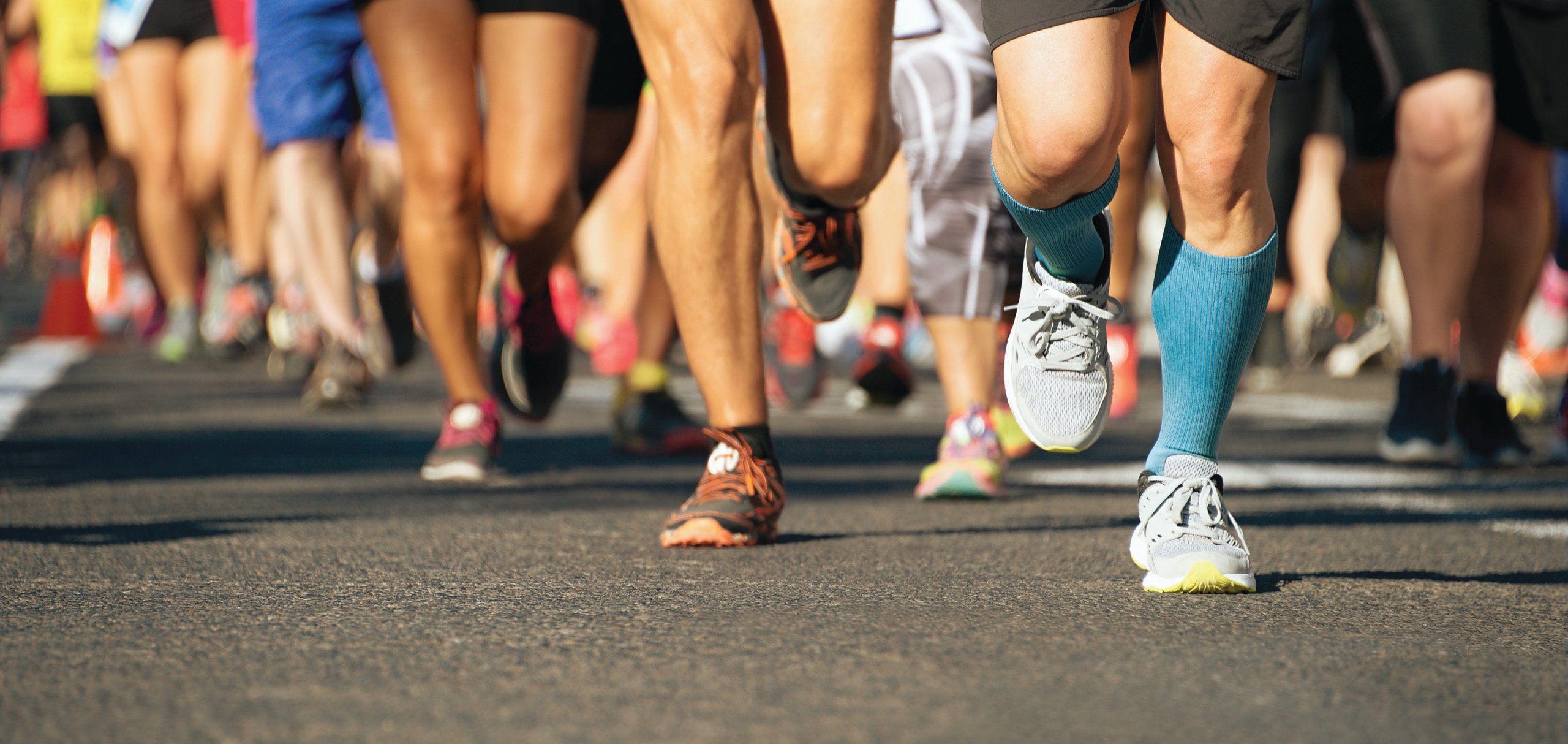Are testosterone levels the best way to categorize male and female athletes?
When an east coast-based cisgender ultrarunner—who asked to remain anonymous—saw the entrant’s pool for a recent competition, she was conflicted. The veteran saw that she would be racing against several familiar names, including Grace Fisher. Fisher had finished ahead of her in several competitions over the last few years; while she was friends with Fisher, whom she called a “sweet and lovely person,” and she supported Fisher’s pursuit of distance running, she questioned whether Fisher should be allowed to compete in the women’s category.
That’s because Fisher is a transgender woman. The 38-year-old was born a man, began running in high school, and started her transition process in 2013. She began entering races as a woman in 2016, having undergone several years of hormone therapy.
Around the world, the question of how to categorize gender in competition has increased in recent years. As athletes as young as 10 and 11, who identify with a gender other than the one they were born with, face their own internal anxieties and questions, governing bodies grapple with how to allow for gender equity as well as fair competition.
“I think many people are willing to accept the athletes gender to which they associate with, at face value, in order to preserve and respect that person‘s feelings, decisions and identity,” the anonymous runner says. “No one wants to appear unsupportive of the societal changes that are occurring now, versus 20 years ago. I understand that completely, but when it comes to the athleticism of males/females, there is more than just hormone levels that divides them and gives the male athlete an advantage. VO2 max, metabolism, and muscle memory—they all play a role.”
When Fisher was granted admission via lottery to the Western States 100-Mile Endurance Run, where almost 6,000 people applied for only 369 spots, race officials realized that they might face similar questions. The Board decided to establish an official policy for transgender women (transgender men can compete without any regulations.)
“Not knowing how [Grace] would do, but knowing that she might be top 10 where awards are recognized, we wanted to consider it ahead of time, so we wouldn’t be scrambling at the last minute if anyone questioned the results,” Diana Fitzpatrick, a board member, says.
Ultimately, Fisher finished 84th overall and 20th amongst females. Still, the question of where transgender or intersex athletes should be allowed to compete continues to be debated.
Fisher said she has felt welcomed by the ultrarunning community, though she realizes that some critics contend with her entrance as female. “In 2016, I placed second as female in the Vermont 100,” Fisher says. “The race director was totally for it, but she got a lot of questions. Some people said I shouldn’t have gotten the second-place award. But she continued to support me. And the majority of runners that I talk to, they’ve been supportive.”
In deciding Western States’ policy, Fitzpatrick and her fellow subcommittee members talked to transgender athletes while also looking at the policies of the Boston Marathon, the New York Marathon and the IOC, amongst others. They also utilized transathlete.com, a resource website created by transgender athlete Chris Mosier, which details information about trans policies in athletics at various levels of competition.
Ultimately, they decided that runners could enter the race under whichever gender they identify with; however, with a top ten finish or age group winner, a transgender woman might need to show medical proof of having undergone hormone therapy for at least one year if her result was challenged by another finisher.
Trans athletes have been allowed to compete in the Olympics since 2003, a policy that was updated to be more inclusive in 2015; still, a transgender athlete has never won a medal. Transgender cyclist Dr. Rachel McKinnon is hoping that the first trans person will finally reach the podium in Tokyo in 2020, even if it’s not herself.
“Legally and socially, trans people have made really big advances in the last five years,” McKinnon says. “That progress is still continuing, but with every marginalized group, there’s a backlash where the pendulum swings. We’re in that right now. The Trump election has exacerbated this – the administration has tried to take away trans rights, and they raise trans athletes as a reason everyone should be against trans people.”
Despite that pushback, McKinnon said, several individual sports have adopted increasingly trans-inclusive policies. Many have followed the lead of the IOC. “One reason the IOC policy is so important is that even for non-Olympic sports, it sets the tone for others,” McKinnon says. “When sports don’t know what policy to pick for trans athletes, it’s easy to say, ‘let’s just do what the Olympics does.’”
Through that policy, trans athletes must first declare their gender. If an athlete declares as female, she cannot change her gender for at least four years while competing. A trans woman must also demonstrate that she has suppressed her total testosterone level in serum below 10 nmol/L for at least 12 months prior to her first competition, a level she must maintain throughout her “desired period of eligibility.” (Transgender men must declare a male gender and cannot change that for at least four years, but they have no medical restrictions.)
But the question remains: do transgender women have a biological advantage? “It’s probably sport-dependent,” Dr. David Clemmons, an endocrinologist out of UNC-Chapel Hill, says, noting also that while some research exists, more research is needed. “A lot of muscle mass is formed before you finish puberty. So, if you underwent a transition after puberty, then you would still have more muscle mass than if you had been born and raised a female. But if you’re running a distance race, it doesn’t matter as much as say, shotput, weightlifting or a discus thrower.”
As far as the biological changes to a transgender woman, “it probably takes about two years to see the effects of being below some level of threshold of male hormone (i.e. taking a testosterone blocker) and having taken feminizing drugs (high dose estrogen),” Dr. Clemmons says. “It’s not super-fast.”
Then there are intersex athletes, such as South African champion Caster Semenya, who recently was barred from competition by the IAAF due to her natural higher levels of testosterone. On this matter, too, opinions are mixed.
“I’m against [banning Semenya], because that wasn’t a conscious decision on the part of the woman to become intersex,” Dr. Clemmons says. “If you’re a man and you want to become a woman, that’s a conscious decision. But this woman was born that way. You can have longer tendons, so you can stretch better, or lighter bone shafts in your legs, so you can run faster. There are a lot of things you can be born with that will make you better or faster.”
Writing in The New Yorker about Semenya in 2016, staff writer Malcolm Gladwell wrote, “I’ve been astonished at how many people fail to appreciate the athletic significance of this. Remember, this is a competitive issue, not a human-rights issue. No one is saying that Semenya isn’t a woman, a human being, and an individual deserving of our full respect … people are only saying that women’s athletics—as a “protected category”—requires her to have testosterone levels in line with her competitors’.”
In Connecticut this summer, three high school students filed a federal discrimination complaint saying a statewide policy on transgender athletes had cost them top finishes in races, and possibly college scholarships. Two transgender athletes were singled out in the lawsuit, one of whom is the defending state champion in the 200 meters (as a statewide high school sports policy, Connecticut allows runners to compete within the gender with which they identify). That case is ongoing.
“While it makes sense, scientifically, to separate sport by gender, it’s very limiting for everybody, especially for trans people,” Gabe Duval, a transgender male and high school sophomore in Charlottesville, Va., says. “For me, wanting to do school sports, I don’t want to be on the girls team, but I can’t be on the boys team. It’s incredibly limiting and frustrating to be on this path of figuring out who you are in this experience, and to be blocked from doing the things that you want to do, when anyone else could have any experience that they wanted to.” [Editor’s note: Via Transathlete.com, The Virginia High School League policy allows a student to participate in sports if they are verified as having “a consistent identity different than the gender listed on the student’s official birth certificate,” or have already begun some form of hormone therapy. The policy emphasizes that the gender identity must be “bona fide” and requires a process that involves a number of officials verifying that identity as well as proof of medications taken, letters of support and more.]
Ultimately, more understanding, support and conversation is needed for athletes of all genders—even if the conversations are sometimes difficult. Because while a universal policy that satisfies all athletes may never exist, at the very least, athletes should be allowed to compete in the way that they feel most comfortable, and as the gender they feel best represents who they are.
“I don’t believe Grace is choosing to [compete as a woman] so she’ll run better as a female,” the anonymous runner says. “I don’t think college or high school students choose to do this with the intention of trying to run at a collegiate level. It’s far too emotional to go through. This isn’t anything that’s intentional or ill-minded. But that’s also why people are sometimes hesitant to talk about it.”







